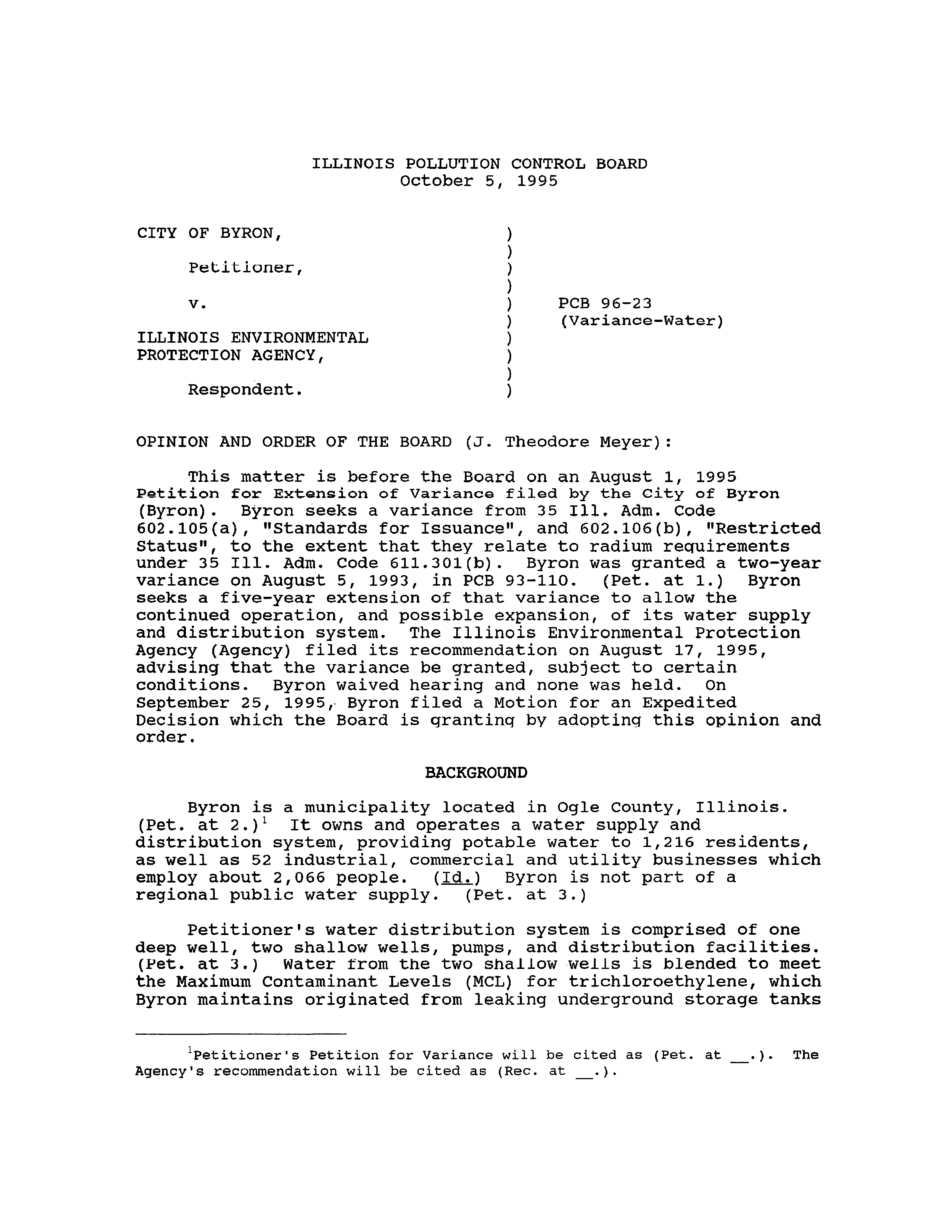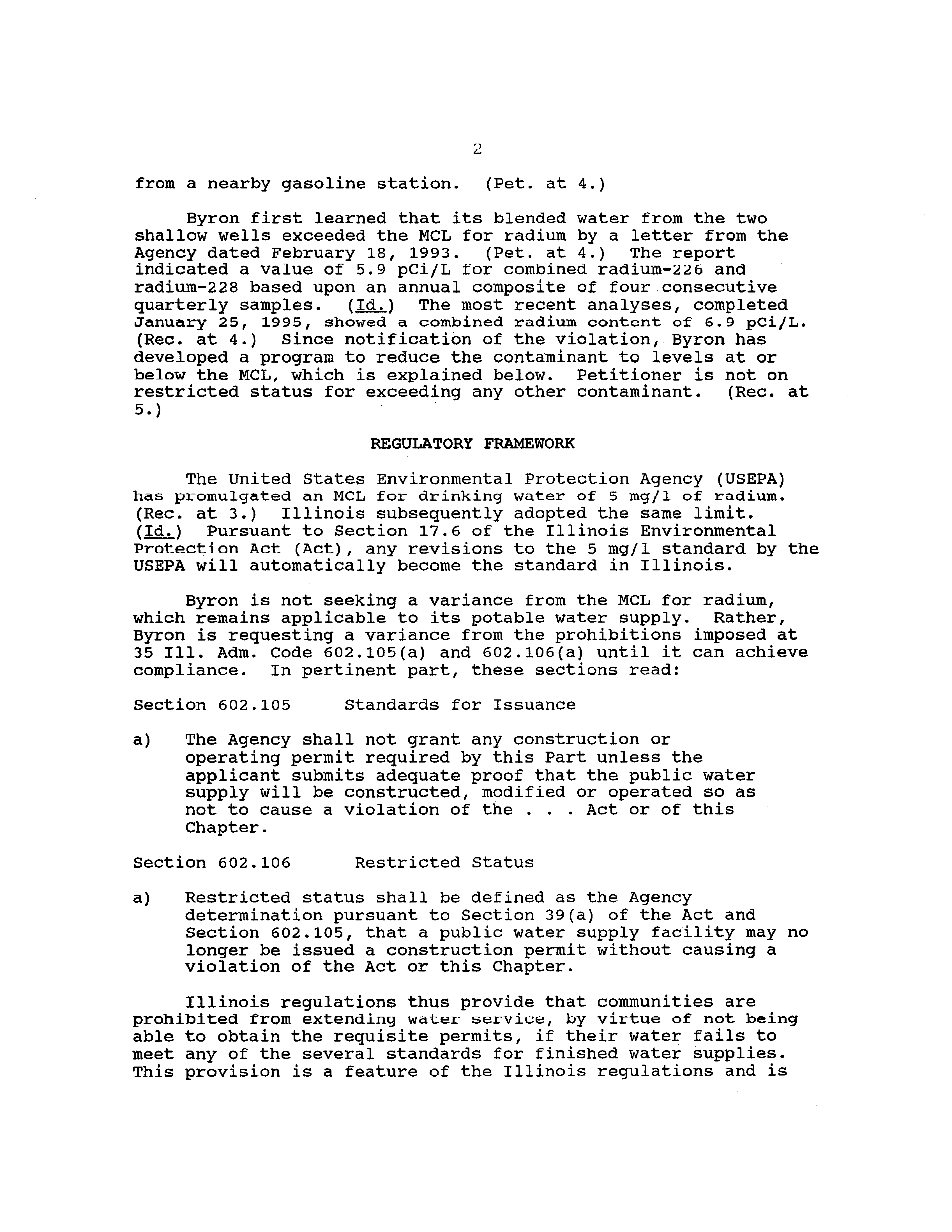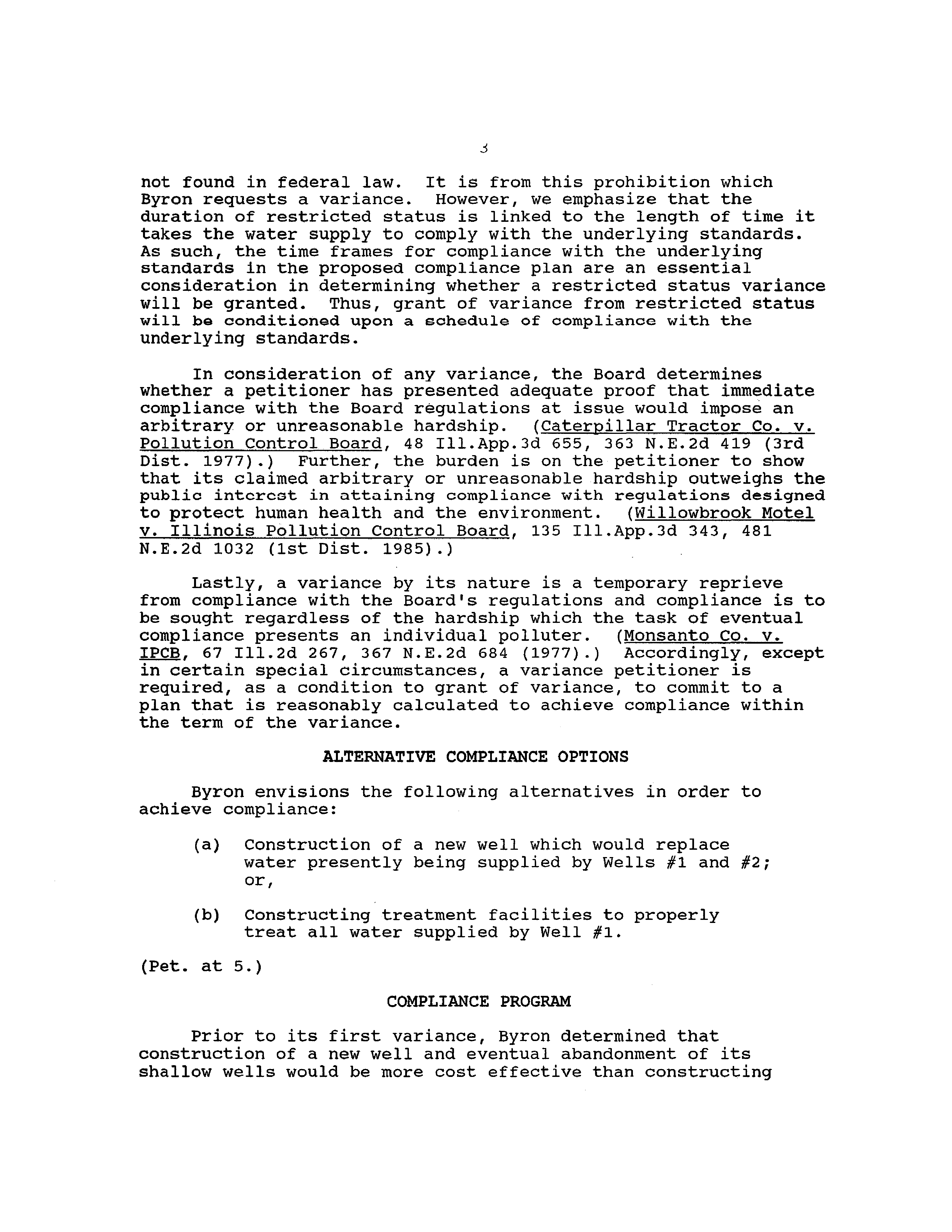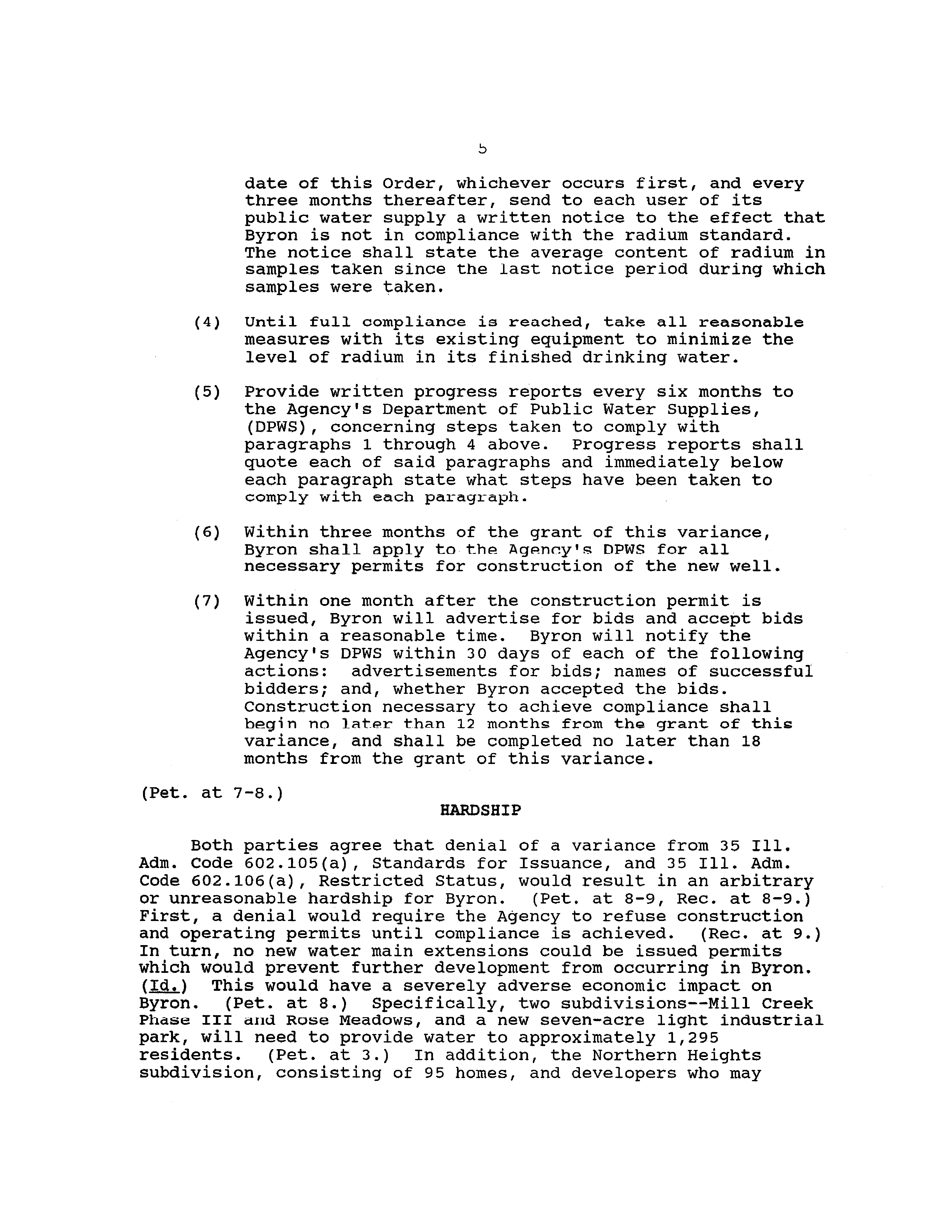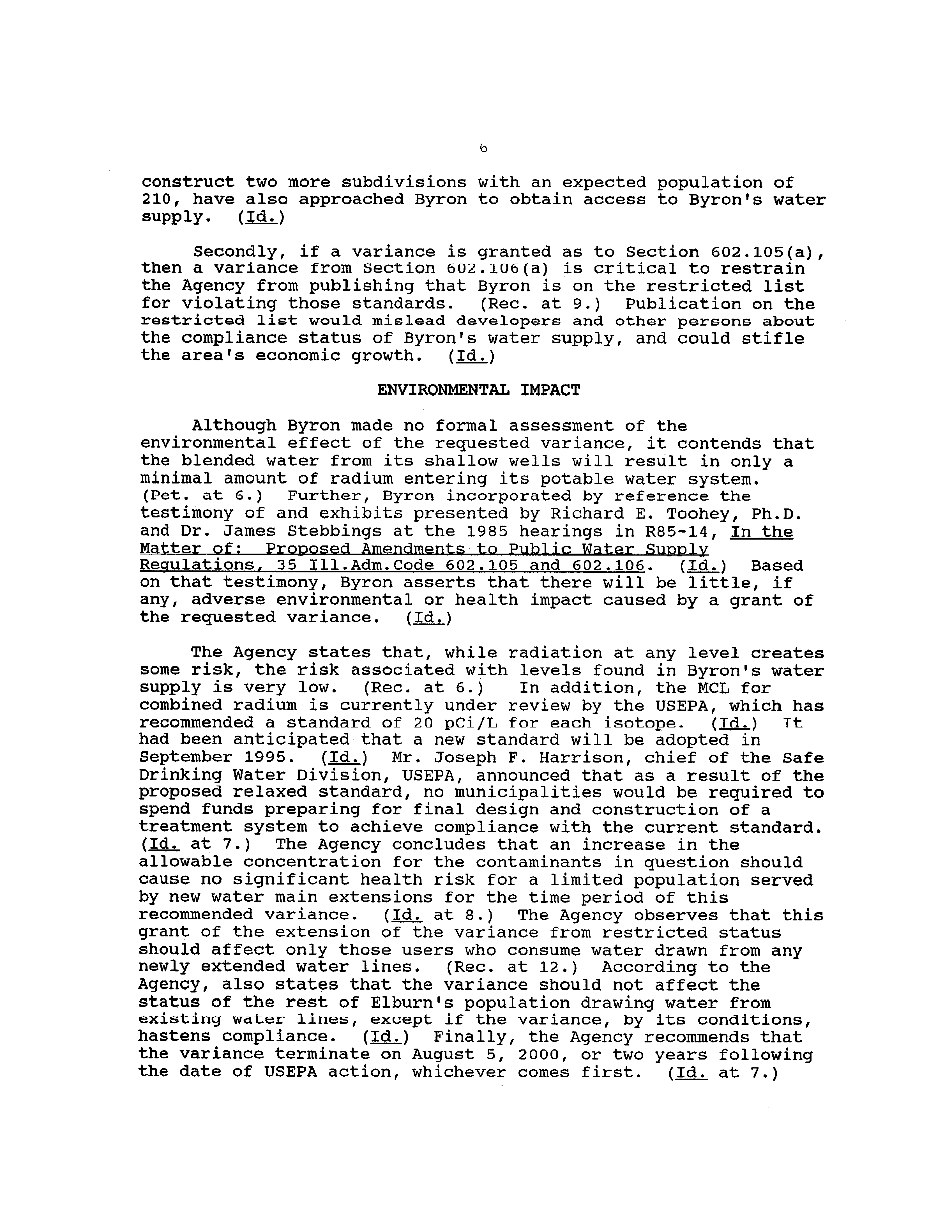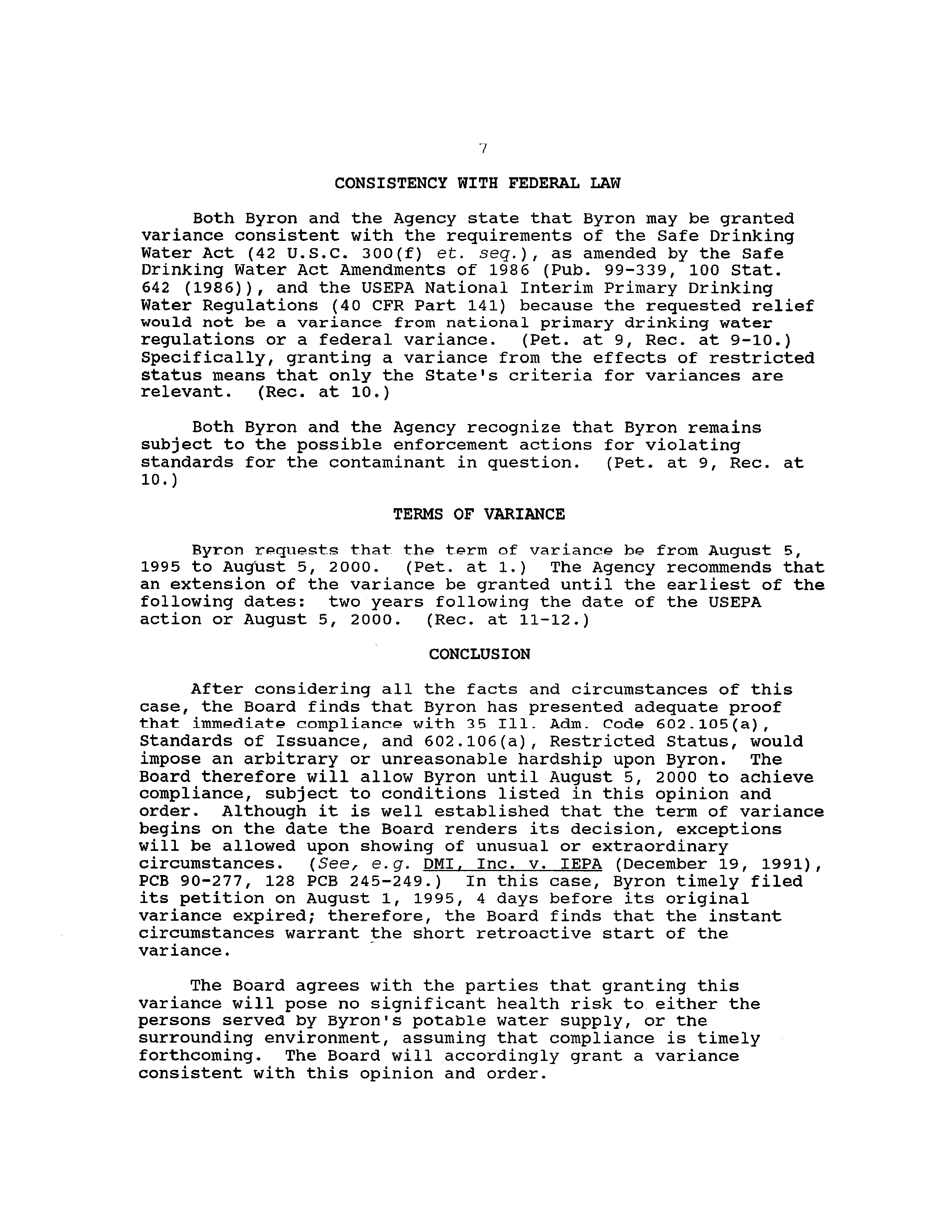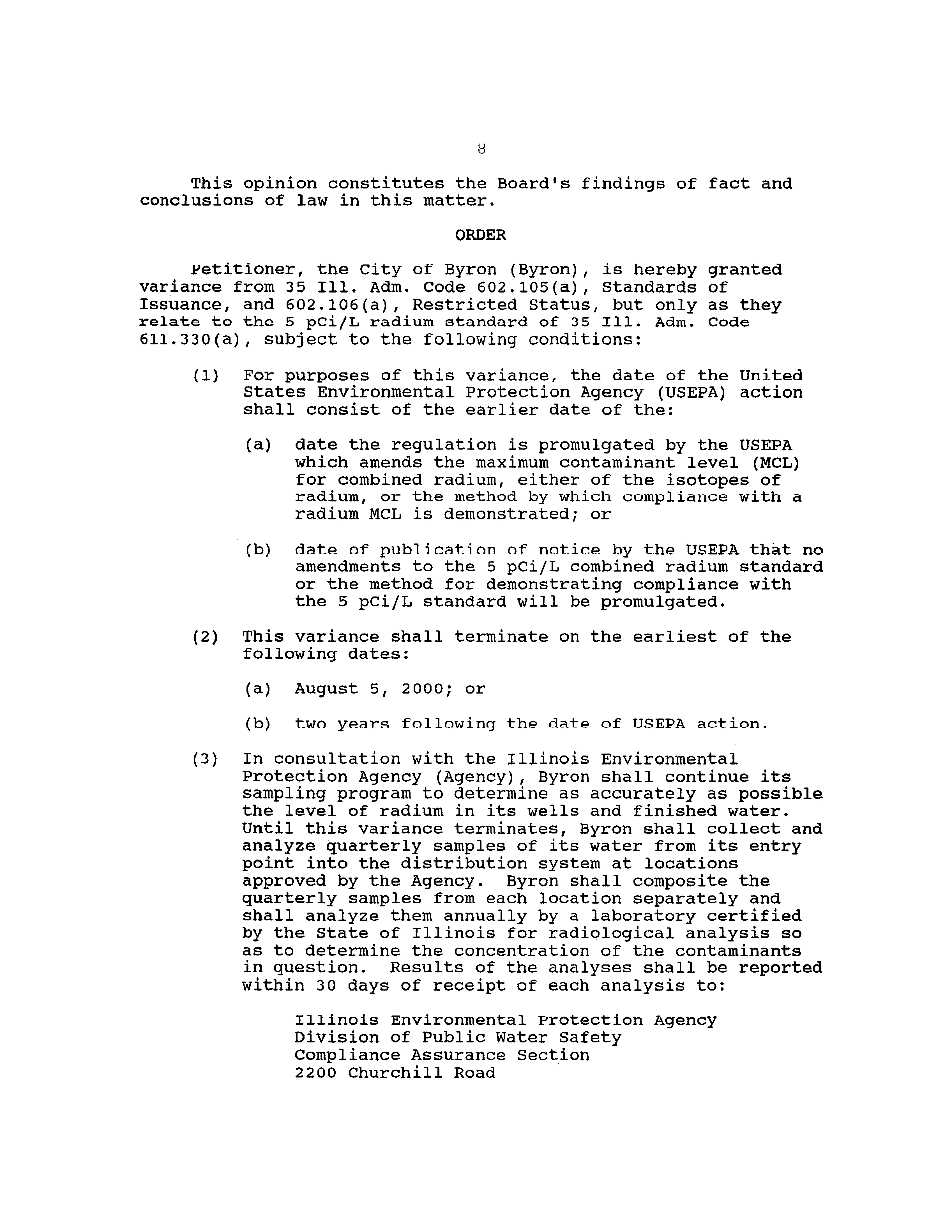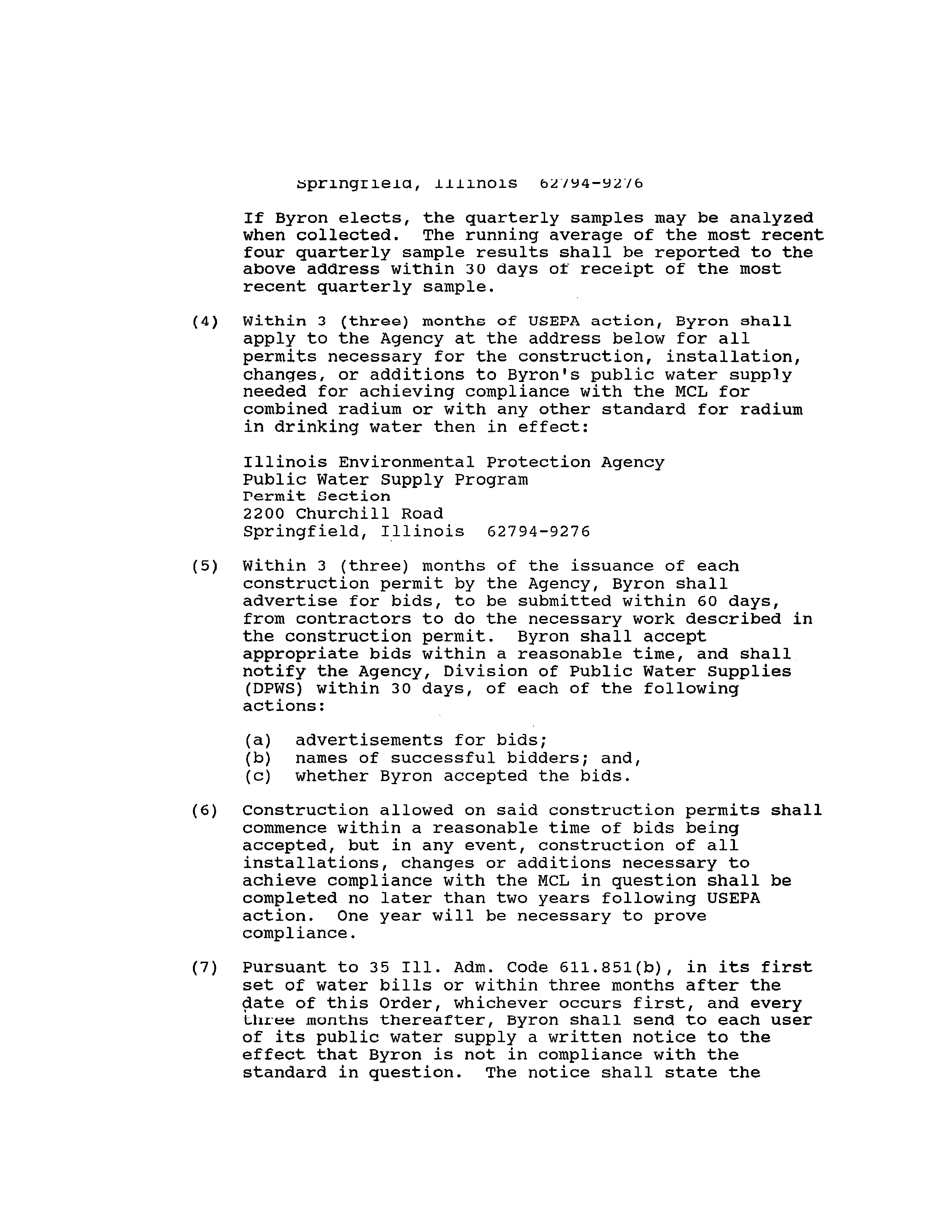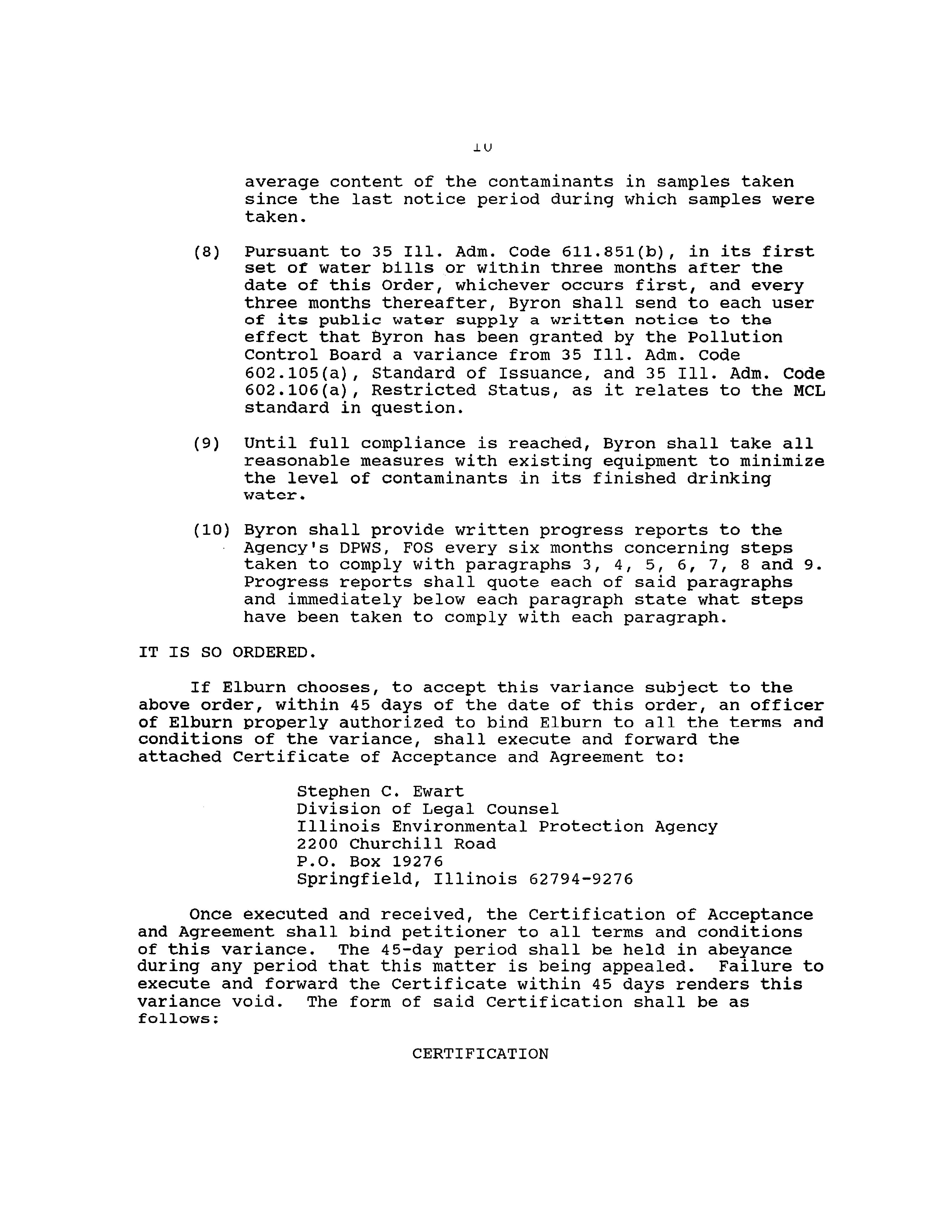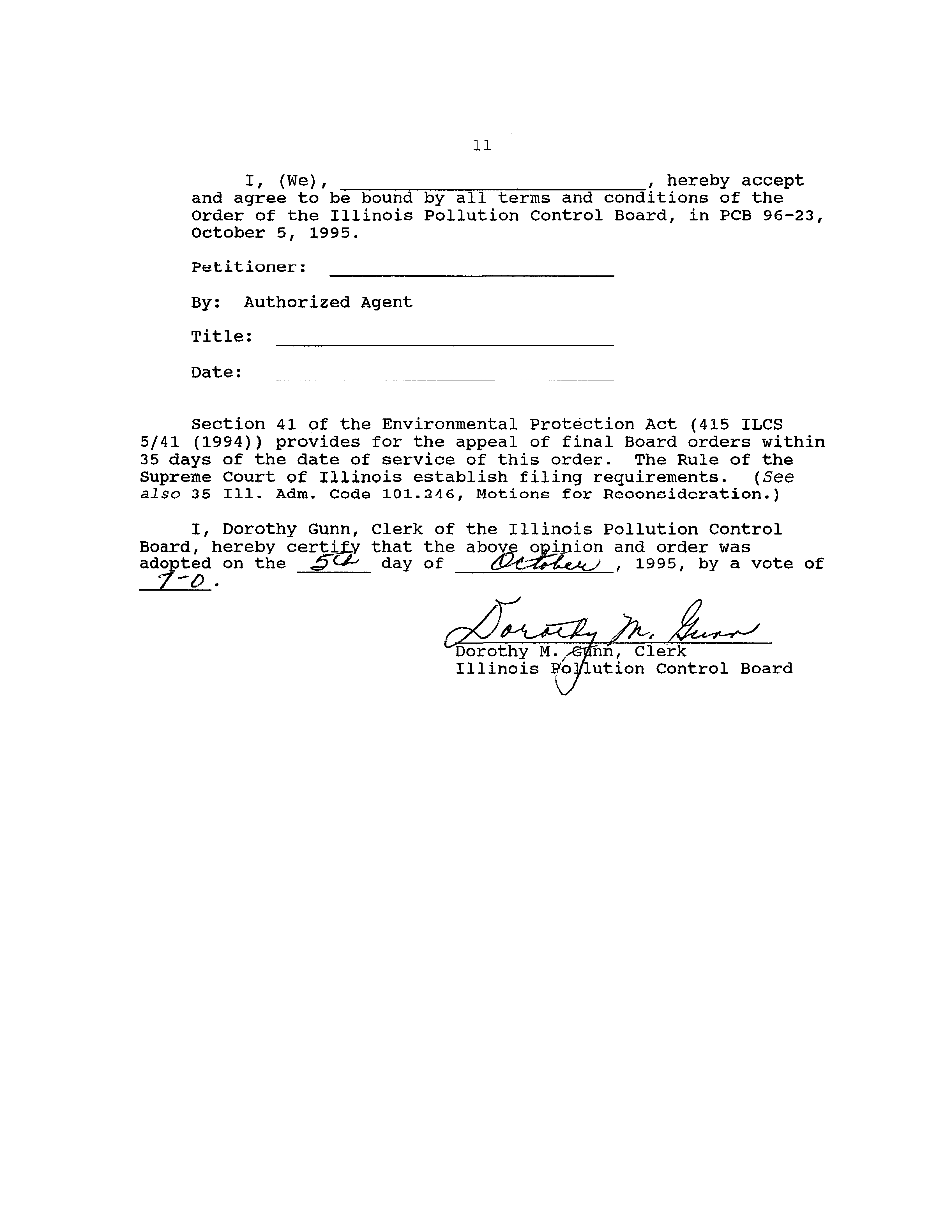ILLINOIS POLLUTION CONTROL BOARD
October
5,
1995
CITY OF BYRON,
)
Petitioner,
v.
)
PCB 96—23
(Variance-Water)
ILLINOIS ENVIRONMENTAL
PROTECTION AGENCY,
)
Respondent.
OPINION
AND
ORDER OF THE BOARD
(J. Theodore Meyer):
This matter is before the Board on an August
1,
1995
Petition for Extension of Variance filed by the City of Byron
(Byron).
Byron seeks a variance from 35 Iii. Adm. Code
602.105(a),
“Standards for Issuance”, and 602.106(b), “Restricted
Status”, to the extent that they relate to radium requirements
under 35 Ill.
Adm. Code 611.301(b).
Byron was granted a two-year
variance on August 5,
1993,
in PCB 93-110.
(Pet.
at
1.)
Byron
seeks a five—year extension of that variance to allow the
continued operation,
and possible expansion,
of its water supply
and distribution system.
The Illinois Environmental Protection
Agency (Agency) filed its recommendation on August 17,
1995,
advising that the variance be granted,
subject to certain
conditions.
Byron waived hearing and none was held.
On
September 25,
1995,
Byron filed a Motion for an Expedited
Decision which the Board is qrantinq by adoptinq this opinion and
order.
BACKGROUND
Byron is a municipality located in Ogle County,
Illinois.
(Pet. at
2.)1
It owns and operates a water supply and
distribution system, providing potable water to 1,216 residents,
as well as 52 industrial, commercial and utility businesses which
employ about 2,066 people.
(~~)
Byron
is not part of a
regional public water supply.
(Pet.
at
3.)
Petitioner’s water distribution system is comprised of one
deep well, two shallow wells, pumps, and distribution facilities.
(Pet.
at
3.)
water trom the two shallow wells is blended to meet
the Maximum Contaminant Levels
(MCL)
for trichioroethylene, which
Byron maintains originated from leaking underground storage tanks
‘Petitioner’s Petition for Variance will be cited as (Pet.
at
.).
The
Agency’s recommendation will be cited as (Rec.
at
.).
2
from a nearby gasoline station.
(Pet.
at 4.)
Byron first learned that its blended water from the two
shallow wells exceeded the NCL for radium by a letter from the
Agency dated February 18,
1993.
(Pet.
at 4.)
The report
indicated a value of 5.9 pCi/L tor combined radium-226 and
radium—228 based upon an annual composite of four consecutive
quarterly samples.
(~~)
The most recent analyses, completed
January 25,
1995,
showed
a
combined radium content of
6.9
pCi/L.
(Rec.
at 4.)
Since notification of the violation,
Byron has
developed a program to reduce the contaminant to levels at or
below the MCL, which is explained below.
Petitioner is not on
restricted status for exceeding any other contaminant.
(Rec.
at
5.)
REGULATORY
FRAMEWORK
The
United
States
Environmental
Protection
Agency
(USEPA)
has
promulgated
an
MCL
for
drinking
water
of
5
mg/l
of
radium.
(Rec.
at
3.)
Illinois
subsequently
adopted
the
same
limit.
(~)
Pursuant to Section 17.6 of the Illinois Environmental
Protection Act
(Act), any revisions to the 5 mg/i standard by the
USEPA will automatically become the standard in Illinois.
Byron is not seeking a variance from the MCL for radium,
which remains applicable to its potable water supply.
Rather,
Byron is requesting a variance from the prohibitions
imposed at
35 Ill. Adm.
Code 602.105(a) and 602.106(a)
until it can achieve
compliance.
In pertinent part,
these sections read:
Section 602.105
Standards for Issuance
a)
The Agency shall not grant any construction or
operating permit required by this Part unless the
applicant submits adequate proof that the public water
supply will be constructed, modified or operated so as
not to cause a violation of the
.
.
.
Act or of this
Chapter.
Section 602.106
Restricted Status
a)
Restricted status shall be defined as the Agency
determination pursuant to Section 39(a)
of the Act and
Section 602.105, that a public water supply facility may no
longer be issued a construction permit without causing a
violation of the Act or this Chapter.
Illinois regulations thus provide that communities are
prohibited
from extending
water
service, by virtue
of
not being
able to obtain the requisite permits,
if their water fails to
meet any of the several standards for finished water supplies.
This provision is a feature of the Illinois regulations and is
not
found
in
federal
law.
It
is
from
this
prohibition
which
Byron
requests
a
variance.
However,
we
emphasize
that
the
duration
of
restricted
status
is
linked
to
the
length
of
time
it
takes
the
water
supply
to
comply
with
the
underlying
standards.
As
such,
the
time
frames
for
compliance
with
the
underlying
standards
In
the
proposed
compliance
plan
are
an
essential
consideration
in
determining
whether
a
restricted
status
variance
will
be
granted.
Thus,
grant
of
variance
from
restricted
status
will
be
conditioned
upon
a
schedule
of
compliance
with
the
underlying
standards.
In
consideration
of
any
variance,
the
Board
determines
whether
a
petitioner
has
presented
adequate
proof
that
immediate
compliance
with
the
Board
regulations
at
issue
would
impose
an
arbitrary
or
unreasonable
hardship.
(Caterpillar
Tractor
Co.
v.
Pollution
control
Board,
48
Ill.App.3d
655,
363
N.E.2d
419
(3rd
Dist.
1977).)
Further,
the
burden
is
on
the
petitioner
to
show
that
its
claimed
arbitrary
or
unreasonable
hardship
outweighs
the
public
intorcc~t
in
attaining
compliance
with
regulations
designed
to
protect
human
health
and
the
environment.
(Willowbrook
Motel
V.
Illinois
Pollution
Control
Board,
135
Ill.App.3d
343,
481
N.E.2d
1032
(1st
Dist.
1985).)
Lastly,
a
variance
by
its
nature
is
a
temporary
reprieve
from
compliance
with
the
Board’s
regulations
and
compliance
is
to
be
sought
regardless
of
the
hardship
which
the
task
of
eventual
compliance
presents
an
individual
polluter.
(Monsanto
Co.
v.
IPCB,
67
Ill.2d
267,
367
N.E.2d
684
(1977).)
Accordingly,
except
in
certain
special
circumstances,
a
variance
petitioner
is
required,
as
a
condition
to
grant
of
variance,
to
commit
to
a
plan
that
is
reasonably
calculated
to
achieve
compliance
within
the
term
of
the
variance.
ALTERNATIVE
COMPLIANCE
OPTIONS
Byron
envisions
the
following
alternatives
in
order
to
achieve
compliance:
(a)
Construction
of
a
new
well
which
would
replace
water
presently
being
supplied
by
Wells
#1
and
#2;
or,
(b)
Constructing
treatment
facilities
to
properly
treat
all
water
supplied
by
Well
#1.
(Pet.
at
5.)
COMPLIANCE
PROGRAM
Prior
to
its
first
variance,
Byron
determined
that
construction
of
a
new
well
and
eventual
abandonment
of
its
shallow
wells
would
be
more
cost
effective
than
constructing
4
treatment facilities.
(Pet.
at
5.)
Since its petition for
variance was granted in 1993, Byron retained a financial
consultant
to
ascertain
how
the
new
well
would
be
financed.
(~~)
It
was
determined
that
alternative
revenue
bonds,
paid
out
of
the
revenue
received
from
water
and
sewer
user
fees,
would
be
issued
to
pay
for
the
new
construction
costs.
(~~)
In
June
1994
the
ordinance
authorizing
the
bonds
was
passed,
and
in
1995,
$1.7
million
of
alternate
revenue
bonds
were
issued.
(Id.)
Byron
is
currently
negotiating
with
a
landowner
to
purchase
property
north
of
the
city
on
which
to
construct
the
new
well
and
a
500,000
gallon
above-ground
storage
tank.
(~~)
Byron
maintains
that
since
the
granting
of
the
variance
in
August
1993,
it
has
followed
the
conditions
set
out
in
the
Board
order,
including:
1.
Collecting
and
testing
quarterly
samples
of
water
from
its
distribution
system
for
radium
concentrations;
2.
Sending
quarterly
notices
to
each
user
of
its
public
water
supply
which
state
that
Byron
is
currently
not
in
comp1i~ince with
the
r~dium etandarci~,
hi.it
that
the
Board
has
granted
it
a
variance
from
those
standards;
and,
3.
Continuing
to
blend
water
from
its
two
shallow
wells
to
reduce
the
level
of
contamination.
(Pet. at 7.)
Byron
states
that
it
will
undertake
the
following
measures
during
the
variance
period
to
minimize
the
impact
of
the
discharge
in
the
affected
area:
(1)
In
consultation
with
the
Agency,
continue
its
sampling
program
to
determine
as
accurately
as
possible
the
level
of
radium
in
its
wells
and
finished
water.
Until
this
variance
expires,
testing
and
reporting
shall
continue.
(2)
Pursuant
to
35
Ill.
Adm.
Code
611.851(b),
in
its
first
set
of
water
bills
or
within
three
months
after
the
date
of
this
Order,
whichever
occurs
first,
and
every
three
months
thereafter,
send
to
each
user
of
its
public
water
supply
a
written
notice
to
the
effect
that
Byron
has
been
granted
by
the
Pollution
Control
Board
a
variance
from
35
Ill.
Adm.
Code
602.105(a),
Standard
of
Issuance,
and
35
Ill.
Mm.
Code
602.106(a),
Restricted
Status,
as
they
relate
to
the
radium
standard.
(3)
Pursuant
to
35
Ill.
Adm.
Code
611.851(b),
in
its
first
set
of
water
bills
or
within
three
months
after
the
5
date of this Order, whichever occurs first, and every
three months thereafter, send to each user of its
public
water
supply
a
written
notice
to
the
effect
that
Byron
is
not
in
compliance
with
the
radium
standard.
The
notice
shall
state
the
average
content
of
radium
in
samples
taken
since
the
last
notice
period
during
which
samples
were
taken.
(4)
Until
full
compliance
is
reached, take
all
reasonable
measures with its existing equipment to minimize the
level of radium in its finished drinking water.
(5)
Provide written progress reports every six months to
the Agency’s Department of Public Water Supplies,
(DPWS),
concerning steps taken to comply with
paragraphs 1 through 4 above.
Progress reports shall
quote each of said paragraphs and immediately below
each paragraph state what steps have been taken to
comply with
each
paragraph.
(6)
Within three months of the grant of this variance,
Byron shall apply to
the
~geney’~ DPWS for all
necessary permits for construction of the new well.
(7)
Within one month after the construction permit is
issued, Byron will advertise for bids and accept bids
within a reasonable time.
Byron will notify the
Agency’s DPWS within 30 days of each of the following
actions:
advertisements for bids; names of successful
bidders;
and, whether Byron accepted the bids.
Construction necessary to achieve compliance shall
begin no
later than
12
months from the grant of this
variance, and shall be completed no later than
18
months from the grant of this variance.
(Pet. at 7-8.)
HARDSHIP
Both parties agree that denial of
a variance from
35 Ill.
Adm. Code 602.105(a), Standards for Issuance,
and 35 Ill.
AcIm.
Code 602.106(a), Restricted Status, would result in an arbitrary
or unreasonable hardship for Byron.
(Pet.
at 8-9,
Rec. at 8-9.)
First, a denial would require the Agency to refuse construction
and operating permits until compliance is achieved.
(Rec.
at 9.)
In turn,
no new water main extensions could be issued permits
which would prevent further development from occurring in Byron.
(~,J
This would have a severely adverse economic impact on
Byron.
(Pet.
at 8.)
Specifically, two subdivisions—-Mill Creek
Phase III and Rose Meadows, and a new seven—acre light industrial
park, will need to provide water to approximately 1,295
residents.
(Pet.
at 3.)
In addition, the Northern Heights
subdivision,
consisting of 95 homes,
and developers who may
construct two more subdivisions with an expected population of
210, have also approached Byron to obtain access to Byron’s water
supply.
(~~)
Secondly,
if
a
variance
is
granted
as to Section 602.105(a),
then
a
variance
from
Section
602.106(a)
is
critical
to
restrain
the
Agency
from
publishing
that
Byron
is
on
the
restricted
list
for
violating
those
standards.
(Rec.
at
9.)
Publication
on
the
restricted
list would mislead developers and other
persons
about
the compliance status of Byron’s water supply, and could stifle
the area’s economic growth.
(~~)
ENVIRONMENTAL IMPACT
Although Byron made no formal assessment of the
environmental effect of the requested variance,
it contends that
the blended water from its shallow wells will result
in only a
minimal amount of radium entering its potable water system.
(Pet.
at
6.)
Further, Byron incorporated by reference the
testimony of and exhibits presented by Richard
E.
Toohey, Ph.D.
and Dr. James Stebbings at the 1985 hearings in R85-14,
In the
Matter of:
Proposed Amendments to Public
Wat.ar. Supply
Regulations,
35 Ill.Adm.Code 602.105 and 602.106.
(~~)
Based
on that testimony,
Byron asserts that there will be little,
if
any, adverse environmental or health impact caused by a grant of
the requested variance.
(~~)
The Agency states that, while radiation at any level creates
some risk, the risk associated with levels found in Byron’s water
supply is very low.
(Rec.
at
6.)
In addition, the MCL for
combined radium is currently under review by the USEPA, which has
recommended a standard of
20 pCi/L for each isotope.
(Li~)
It
had been anticipated that a new standard will be adopted in
September 1995.
(~~)
Mr. Joseph F.
Harrison, chief of the Safe
Drinking Water Division, USEPA, announced that as a result of the
proposed relaxed standard,
no municipalities would be required to
spend funds preparing for final design and construction of
a
treatment system to achieve compliance with the current standard.
~
at 7.)
The Agency concludes that an increase in the
allowable concentration for the contaminants in question should
cause no significant health risk for a limited population served
by new water main extensions for the time period of this
recommended variance.
(j~
at
8.)
The Agency observes that this
grant of the extension of the variance from restricted status
should affect only those users who consume water drawn from any
newly extended water lines.
(Rec.
at 12.)
According to the
Agency, also states that the variance should not affect the
status of the rest of Elburn’s population drawing water from
existing water lines, except if the variance,
by its conditions,
hastens compliance.
(~~)
Finally, the Agency recommends that
the variance terminate on August 5,
2000,
or two years following
the date of USEPA action, whichever comes first.
~
at
7.)
7
CONSISTENCY WITH
FEDERAL
LAW
Both Byron and the Agency state that Byron may be granted
variance consistent with the requirements of the Safe Drinking
Water Act
(42 U.S.C.
300(f)
et.
seq.),
as
amended
by
the
Safe
Drinking Water Act Amendments
of 1986
(Pub.
99-339,
100 Stat.
642
(1986)), and the USEPA National Interim Primary Drinking
Water Regulations
(40 CFR Part 141) because the requested relief
would not be
a
variance from national primary drinking water
regulations or a federal variance.
(Pet. at
9, Rec.
at 9-10.)
Specifically, granting a variance from the effects of restricted
status means that only the State’s criteria for variances are
relevant.
(Rec.
at 10.)
Both Byron and the Agency recognize that Byron remains
subject to the possible enforcement actions for violating
standards for the contaminant in question.
(Pet.
at
9, Rec.
at
10.)
TERMS
OF
VARIANCE
Byron
requests
that. the term of variance
he from August
5,
1995 to August
5,
2000.
(Pet.
at
1.)
The Agency recommends that
an extension of the variance be granted until the earliest of the
following dates:
two years following the date of the USEPA
action or August
5,
2000.
(Rec. at 11—12.)
CONCLUSION
After considering all the facts and circumstances of this
case,
the Board finds that Byron has presented adequate proof
that immediate compliance with 35 Ill. Adm.
Code 602.105(a),
Standards of Issuance, and 602.106(a), Restricted Status, would
impose an arbitrary or unreasonable hardship upon Byron.
The
Board therefore will allow Byron until August 5,
2000 to achieve
compliance, subject to conditions listed in this opinion and
order.
Although it is well established that the term of variance
begins on the date the Board renders its decision, exceptions
will be allowed upon showing of unusual or extraordinary
circumstances.
(See,
e.g.
DM1,
Inc.
v. IEPA (December 19, 1991),
PCB 90-277,
128 PCB 245—249.)
In this case,
Byron timely filed
its petition on August 1,
1995,
4 days before its original
variance expired; therefore,
the Board finds that the instant
circumstances warrant the short retroactive start of the
variance.
The Board agrees with the parties that granting this
variance will pose no significant health risk
to. either the
persons served by Byron’s potable water supply,
or the
surrounding environment,
assuming that compliance is timely
forthcoming.
The Board will accordingly grant a variance
consistent with this opinion and order.
U
This opinion constitutes the Board’s findings of fact and
conclusions of law in this matter.
ORDER
Petitioner, the City of Byron
(Byron),
is hereby granted
variance from 35 Ill.
Adm. Code 602.105(a), Standards of
Issuance, and 602.106 (a), Restricted Status,
but only as they
relate
to
the
5 pCi/L radium standard of 35 Iii. Mm.
Code
611.330(a), subject to the following conditions:
(1)
For purposes of this variance, the date of the United
States Environmental Protection Agency
(USEPA) action
shall consist of the earlier date of the:
(a)
date the regulation is promulgated by the USEPA
which amends the maximum contaminant level
(MCL)
for combined radium, either of the isotopes of
radium, or the method by which compliance with a
radium MCL is demonstrated; or
(b)
date of pub1ic~tinnof notice by the USEPA that no
amendments to the 5 pCi/L combined radium standard
or the method for demonstrating compliance with
the 5 pCi/L standard will be promulgated.
(2)
This variance shall terminate on the earliest of the
following dates:
(a)
August
5,
2000;
or
(b)
two years following the date
of USEPA
action.
(3)
In consultation with the Illinois Environmental
Protection Agency
(Agency), Byron shall continue its
sampling program to determine as accurately as possible
the level of radium in its wells and finished water.
Until this variance terminates, Byron shall collect and
analyze quarterly samples of its water from its entry
point into the distribution system at locations
approved by the Agency.
Byron shall composite the
quarterly samples from each location separately and
shall analyze them annually by a laboratory certified
by the State of Illinois for radiological analysis so
as to determine the concentration of the contaminants
in question.
Results of the analyses shall be reported
within
30 days of receipt of each analysis to:
Illinois Environmental Protection Agency
Division of Public Water Safety
Compliance Assurance Section
2200 Churchill Road
~pringr1e1a,
.L1.LIflO1S
62/94—92/6
If Byron elects, the quarterly samples may be analyzed
when collected.
The running average of the most recent
four quarterly sample results shall be reported to the
above address within 30 days at receipt of the most
recent quarterly sample.
(4)
Within
3
(three) months
of
USEPA action, Byron 8hall
apply to the Agency at the address below for all
permits necessary for the construction,
installation,
changes,
or additions to Byron’s public water suppiy
needed for achieving compliance with the MCL for
combined radium or with any other standard for radium
in drinking water then in effect:
Illinois Environmental Protection Agency
Public Water Supply Program
Permit Section
2200 Churchill Road
Springfield, Illinois
62794—9276
(5)
Within 3
(three) months of the issuance of each
construction permit by the Agency, Byron shall
advertise for bids,
to be submitted within 60 days,
from contractors to do the necessary work described in
the construction permit.
Byron shall accept
appropriate bids within a reasonable time,
and shall
notify the Agency, Division of Public Water Supplies
(DPWS)
within 30 days,
of each of the following
actions:
(a)
advertisements
for bids;
(b)
names of successful bidders;
and,
(c)
whether Byron accepted the bids.
(6)
Construction allowed on said construction permits shall
commence within a reasonable time of bids being
accepted, but in any event, construction of all
installations, changes or additions necessary to
achieve compliance with the MCL in question shall be
completed no later than two years following USEPA
action.
One year will be necessary to prove
compliance.
(7)
Pursuant to 35 Ill. Adm.
Code 611.851(b),
in its first
set of water bills or within three months after the
çiate of this Order, whichever occurs first, and every
three months
therearter,
Byron shall
send
to each user
of its public water supply a written notice to the
effect that Byron is not in compliance with the
standard in question.
The notice shall state the
i-u
average content of the contaminants in samples taken
since the last notice period during which samples were
taken.
(8)
Pursuant to 35 Ill. Adm. Code 611.851(b),
in its first
set or water bills or within three months after the
date of this Order, whichever occurs first,
and every
three months thereafter, Byron shall send to each user
of
its
public
water supply
a written notice
to the
effect that byron has been granted by the Pollution
Control Board a variance from 35 Ill. Adm. Code
602.105(a), Standard of Issuance,
and 35 Ill.
Adni.
Code
602.106(a), Restricted Status,
as it relates to the MCL
standard in question.
(9)
Until full compliance is reached, Byron shall take all
reasonable measures with existing equipment to minimize
the level of contaminants in its finished drinking
water.
(10)
Byron shall provide written progress reports to the
Agency’s DPWS,
FOS every six months concerning steps
taken to comply with paragraphs
3,
4,
5,
6,
7,
8 and 9.
Progress reports shall quote each of said paragraphs
and immediately below each paragraph state what steps
have been taken to comply with each paragraph.
IT IS SO ORDERED.
If Elburn chooses,
to accept this variance subject to the
above order, within 45 days of the date of this order, an officer
of Elburn properly authorized to bind Elburn to all the terms And
conditions of the variance, shall execute and forward the
attached Certificate of Acceptance and Agreement to:
Stephen
C.
Ewart
Division of Legal Counsel
Illinois Environmental Protection Agency
2200 Churchill Road
P.O. Box
19276
Springfield,
Illinois 62794—9276
Once executed and received, the Certification of Acceptance
and Agreement shall bind petitioner to all terms and conditions
of this variance.
The 45-day period shall be held in abeyance
during any period that this matter
is being appealed.
Failure to
execute and forward the Certificate within 45 days renders this
variance void.
The form of said Certification shall be as
follows;
CERTIFICATION
11
I,
(We),
________________________-,
hereby accept
and agree to be bound by all terms and conditions of the
Order of the Illinois Pollution Control Board,
in PCB 96-23,
October
5,
1995.
Petitioner;
___________________________
By:
Authorized Agent
Title:
_______________________________
Date:
Section 41 of the Environmental Protection Act
(415 ILCS
5/41
(1994)) provides for the appeal of final Board orders within
35 days of the date of service of this order.
The Rule of the
Supreme Court of Illinois establish filing requirements.
(See
also
35 Ill. Adm. Code
101.246,
Motions for Reconsideration.)
I, Dorothy Gunn,
Clerk of the Illinois Pollution Control
Board, hereby certjfy that the aboy~owJ~nionand order was
adopted on the
ffC.I~i day of
_____________,
1995,
by a vote of
7~.
Dorothy M./~y~nn,Clerk
Illinois
lution Control Board
